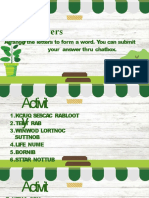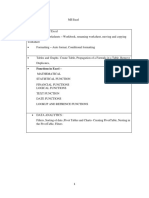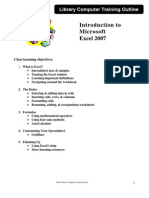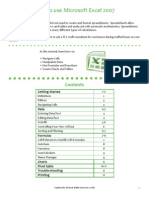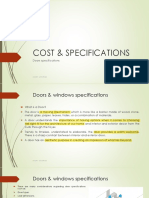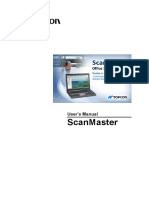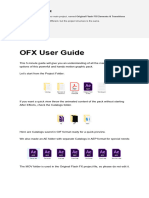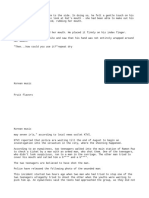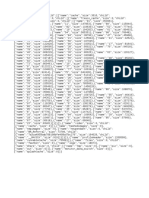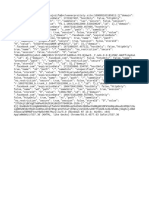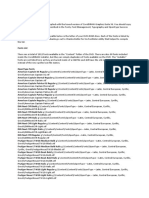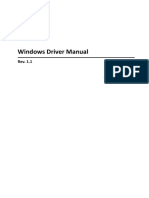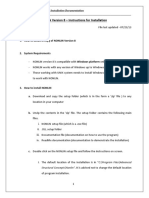Excel Mastery for Beginners
Balaji Commerce Classes and Tally Academy Satana. Mo. No.: 9604041061
[Type here]
� Complete User Interface
[Type here]
�Basic Terms :
1. Ribbon: Ribbon is like an expanded menu. It depicts all the features
of Excel in easy-to-understand form. Since Excel has 1000s of
features, they are grouped in to several ribbons. The most important
ribbons are – Home, Insert, Formulas, and Page Layout & Data.
2. Quick Access Toolbar: This is a place where all the important tools
can be placed. When you start Excel for the very first time, it has
only 3 icons (Save, Undo, and Redo). But you can add any feature of
Excel to to Quick Access Toolbar so that you can easily access it
from anywhere (hence the name).
3. Formula Bar:
This is where any calculations or formulas you write will appear. You will
understand the relevance of it once you start building formulas.
4. Spreadsheet Grid:
This is where all your numbers, data, charts & drawings will go. Each Excel
file
can contain several sheets. But the spreadsheet grid shows few rows &
columns
of active spreadsheet. To see more rows or columns you can use the scroll
bars
to the left or at bottom. If you want to access other sheets, just click on the
sheet name (or use the shortcut CTRL+Page Up or CTRL+Page Down).
5. Status bar:
This tells us what is going on with Excel at any time. You can tell if Excel is
busy calculating a formula, creating a pivot report or recording a macro by
just
looking at the status bar. The status bar also shows quick summaries of
selected cells (count, sum, average, minimum or maximum values). You can
change this by right clicking on it and choosing which summaries to show.
The Ribbon
Understanding the Ribbon is a great way to help understand the changes
between Microsoft 2003 to Microsoft 2007/2010. The ribbon holds all of the
information in previous versions of Microsoft Office in a more visual stream
line
manner through a series of tabs that include an immense variety of program
features.
Home Tab
This is the most used tab; it incorporates all text and cell formatting features
such as font and paragraph changes. The Home Tab also includes basic
spreadsheet formatting elements such as text wrap, merging cells and cell
style.
Insert Tab
[Type here]
�This tab allows you to insert a variety of items into a document from pictures, clip art, and headers
and footers
Page Layout Tab
This tab has commands to adjust page such as margins, orientation and
themes.
Formulas Tab
This tab has commands to use when creating Formulas. This tab holds
an immense function library which can assist when creating any
formula or function in your spreadsheet.
Data Tab
This tab allows you to modifying worksheets with large amounts of data by
sorting and filtering as well as analyzing and grouping data.
Review Tab
This tab allows you to correct spelling and grammar issues as well as
set up security protections. It also provides the track changes and
notes feature providing the ability to make notes and changes
someone’s document.
View Tab
This tab allows you to change the view of your document including freezing
or splitting panes, viewing gridlines and hide cells.
The Excel Worksheet (Spreadsheet) and Workbook
An Excel worksheet, or spreadsheet, is a two-dimensional grid with columns
and rows. Look at the spreadsheet below. The column names are letters of
the alphabet starting with A, and the rows are numbered chronologically
starting with the number one. The cells in the first roware A1, B1, C1, and
so on. And the cells in the first column are A1, A2, A3, and so on. These are
called cell names or cell references.
We use cell references when creating math formulas or functions. For
example, the formula to add the contents of cells B2 and B3 together
is: =B2+B3.
[Type here]
�The Name Box is located in the area above Column A, and displays the cell
reference of the selected cell - the cell where the cursor is resting. In our
spreadsheet above, the selected cell is C2. Notice that the column letter (C)
and the row number (2) change color.
The beginning of the Formula Bar can be seen in the area above Column D
on our worksheet. The Formula Bar displays the contents of the selected
cell.
A workbook is a collection of worksheets or spreadsheets. When the Excel
program is opened, a workbook opens with three blank worksheets. The
names of the worksheets are displayed on tabs at the bottom of the Excel
window.
Moving From Cell to Cell
The arrow keys can be used to move left, right, up, and down from the
current cell. Press the Enter key to move to the cell immediately below the
current cell, and press the Tab key to move one cell to the right.
Selecting Cells or Range
In order to complete more advanced processes in Excel you need to be able
to highlight or select cells, rows and columns. There are a variety of way to
do this, see the table below to understand the options.
[Type here]
�Propagating Cell Contents
There are multiple ways to propagate or fill data from one cell to adjacent
cells. Let's begin with two popular keyboard shortcuts that allow us to fill
down, or fill to the right:
To fill adjacent cells with the contents of the cell above, select the cell
with the data and the cells to be filled and press Ctrl + D (the Ctrl key
and the D key) to fill down.
To fill adjacent cells with the contents of the cell to the left, select the cell
with the data and cells to be filled and press Ctrl + R (the Ctrl key and
the R key) to fill to the right.Page 14 of 87
DR. MCR HRD INSTITUTE OF TELANGANA
To propagate in any direction, use the Fill Handle. Click in a cell with data
to be copied, hover the cursor over the cell's lower right corner until the
cursor changes to a thin plus sign (+) or a dark square, and drag up, down,
left, or right to fill the cells. Excel's Fill Handle is powerful; see our Fill
Handle tutorial.
If the data to be copied is a date, number, time period, or a custom-made
series, the data will be incremented by one instead of just copied when the
Fill Handle is used. For example, to display the months of the year in
[Type here]
�column A, type January in cell A1, drag the Fill Handle down to cell A12,
and the months will display, in order, in column A!
3. Modifying Spreadsheets
In order to create an understandable and professional document you
will need to make adjustments to the cells, rows, columns and text. Use
the following processes to assist when creating a spreadsheet.
Cut, Copy, and Paste Data
You can use the Cut, Copy, and Paste commands in Microsoft Office
Excel to move or copy entire cells or their contents. NOTE: Excel displays
an animated moving border around cells that have been cut or copied. To
cancel a moving border, press ESC.
Move/Copy Cells
When you move or copy a cell, Excel moves or
copies the entire cell, including formulas and their
resulting values, cell formats, and comments.
1. Select the cells that you want to move or copy.
2. On the Home tab, in the Clipboard group, do one of the following:
a. To move cells, click Cut
b. To copy cells, click Copy
3. Click in the center of the cell you would like to Paste the information too.
4. On the Home tab, in the Clipboard group, click Paste
NOTES: Excel replaces existing data in the paste area when you cut and
paste cells to move them. When you copy cells, cell references are
automatically adjusted. If the selected copy or paste area includes hidden
cells, Excel also copies the hidden cells. You may need to temporarily
unhide cells that you don't want to include when you copy information
[Type here]
� Kyuri Padalia
[Type here]













